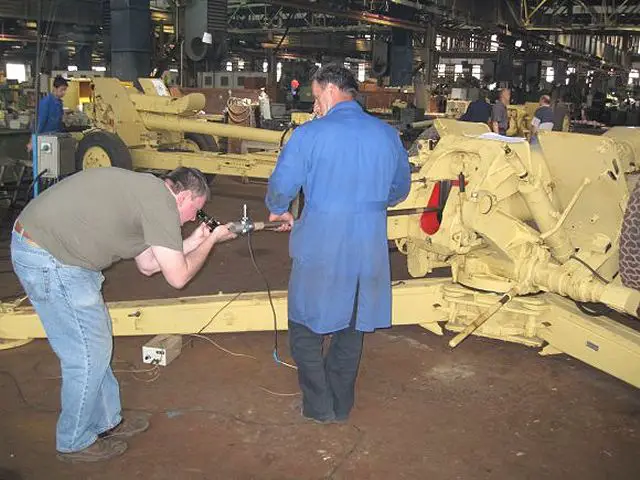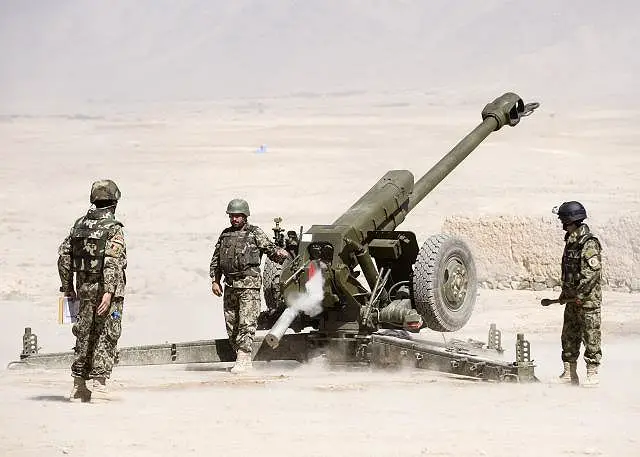Breaking news
United States defence industry is helping the Afghan Army to bolster artillery capabilities 0911112.
| a | |||
Defense News - Afghanistan |
|||
| Wednesday, November 9, 2011, 09:18 AM | |||
| United States defence industry is helping the Afghan Army to bolster their artillery capabilities. | |||
United
States Picatinny Arsenal is helping the Afghan National Army develop their
indirect fire capability to bolster self-defense. Picatinny, in conjunction
with the Combined Security Transition Command-Afghanistan, will support
the acquisition of 194 D30, 122mm Howitzers for the Afghan National Army. |
|||
 Joe Kurowsky, an Armament Research Development & Engineering Center employee and D30 inspection team cannon expert from Benet Laboratories in Watervliet Arsenal, N.Y., uses a boroscope to examine the interior of the barrel for any cracks or abnormalities at BNT Travnik, Bosnia and Herzegovina during one of the inspections. (Photo Credit: U.S. Army) |
|||
|
In addition to supporting the acquisition of the howitzers, the Program
Executive Office Ammunition, or PEO Ammo, has also helped establish
a training and mentoring program at the Central Work Shop in Kabul,
Afghanistan. At the CWS, mentors/instructors are teaching an Afghan
work force how to properly overhaul, repair and maintain the weapons. |
|||
 Afghan National Army instructors fire artillery from the 122 milimeter howitzer D-30 Oct. 4, 2010. This demonstation marked the end of the train the trainer course and the opening ceremony for the artillery school where these instructors will teach. (Photo Credit: Senior Airman Zachary Wolf U.S. Army site) |
|||
|
Afghans are familiar with the D30 Howitzer capability,
said Ray Espinosa, the ARDEC Project Officer for the D30 Howitzer Program.
The D30 was developed by the Soviets in the 1960s and is still the most widely used howitzer in the world today. The Soviets brought the D30 to Afghanistan when they occupied the country in the 1980s. Even though the Soviet Army eventually left, their howitzers remained behind. "The Afghans have been using them ever since, but have not had the resources or training to maintain them, so the howitzers have deteriorated through the years," Espinosa said. HELP FROM FOREIGN PARTNERS Picatinny's PM TAS has been tasked with procuring the D30s, overseeing the refurbishing of the howitzers, inspecting them to ensure they are operable and then delivering them to troops in Afghanistan. To achieve this, PM TAS and ARDEC employees are working closely with Eastern European countries that are familiar with and have access to D30s. So far PM TAS has procured and delivered 44 D-30 howitzers from the Ukraine, initiated the procurement of 60 weapons from Bosnia i Herzegovina and helped the Afghan National Army refurbish 17 weapons in their Central Work Shop. The Bosnia i Herzegovina government donated the 60 howitzers to the program. "Bosnia has a surplus of weapons and it costs them money to maintain these weapons because they have to store them and make sure they're secure," Espinosa said. "They donated 60 howitzers whose conditions range from lightly worn to heavily used. So we decided to put the howitzers through a refurbishing program before we turned them over to the Afghan National Army," to ensure consistent quality throughout the fleet. That refurbishing is being done in Bosnia i Herzegovina with the Bosnia i Herzegovina company UNIS Group serving as the prime contractor that oversees three component factories also within country. The three factories disassemble the weapons, then refurbish and reassemble the howitzers. If they pass a final inspection conducted by ARDEC employees, they are sent to the Afghan National Army. The D30 team saved around $7 million refurbishing the howitzers from Bosnia i Herzegovina. "We had initial estimates of $12 million, but by contracting directly with the BiH firm, we were able to bring that down to about $5.4 million," Gooding said. "So we saved approximately $7 million by going directly to the firm in BiH." To mark the first delivery of eight howitzers from Bosnia i Herzegovina, the Bosnia i Herzegovina government held a ceremony at the Sarajevo Airport on July 25 to celebrate the first shipment of howitzers to Afghanistan. "Today is an important day for military cooperation and partnership," said Patrick S. Moon, the U.S. Ambassador to Bosnia i Herzegovina. "We stand together, as NATO allies and partner nations, in assisting the government of Afghanistan to build its security capabilities." "I
am proud to be here as the first shipment of 60 D30 Howitzers -- donated
by the government of Bosnia i Herzegovina and refurbished by the U.S.
government -- is sent to the Afghan National Army. The government of Bosnia
i Herzegovina's donation assists Afghanistan to build a modern and well-equipped
army capable of ensuring a safe and secure environment for all Afghan
citizens." |
|||



















